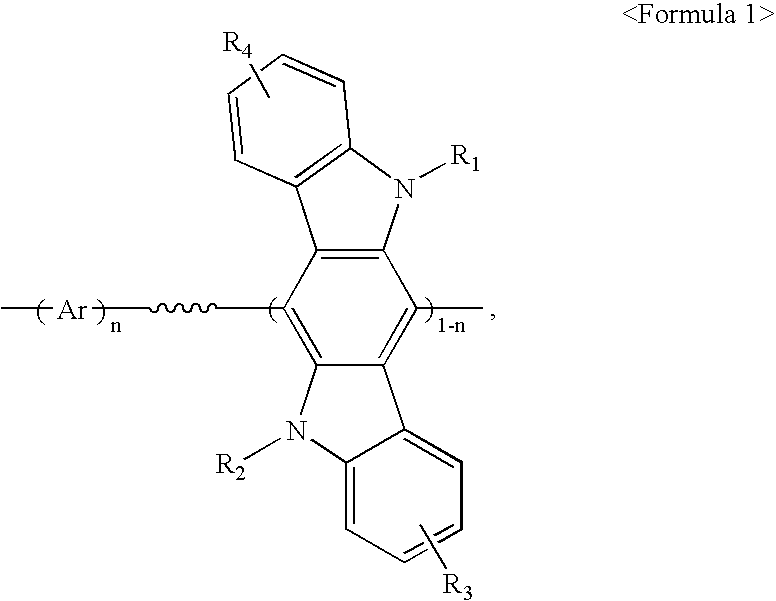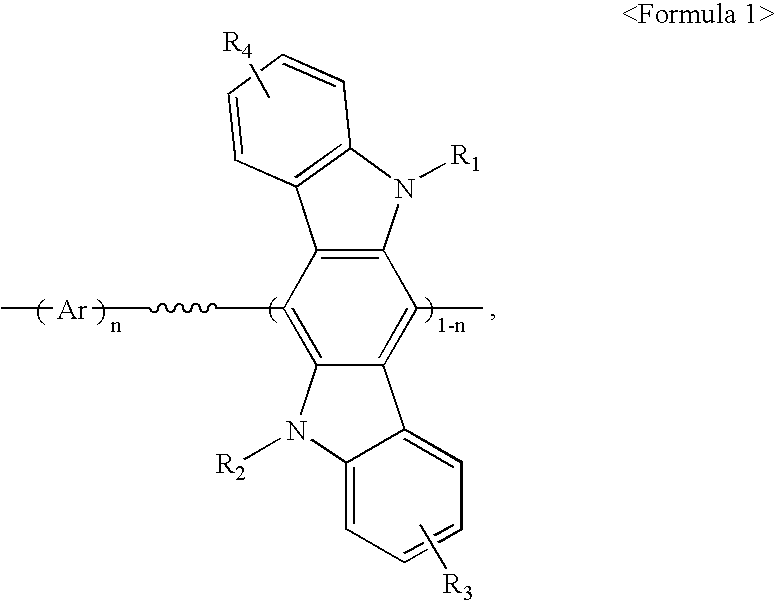Blue electroluminescent polymer and organo-electroluminescent device employing the same
a technology of electroluminescent polymer and organoelectroluminescent device, which is applied in the direction of discharge tube luminescnet screen, other domestic articles, natural mineral layered products, etc., can solve the problems of low emission efficiency, high drive voltage, and low color purity
- Summary
- Abstract
- Description
- Claims
- Application Information
AI Technical Summary
Problems solved by technology
Method used
Image
Examples
preparation example 2
[0079] Synthesis of 9,9'-dioctyl-2,7-dibromofluorene Compound F
[0080] 2,7-dibromofluorene (25 g (77 mmol)) and octylbromide were dissolved in 100 ml of toluene, and 1.25 g (3.85 ml) of tetrabutyl ammonium bromide (TBAB) was added thereto. To the resulting mixture was added NaOH aqueous solution obtained by dissolving 31 g (770 mmol) of NaOH in 50 ml of water, and was refluxed for 2 days.
[0081] After the reaction was completed, the reaction mixture was extracted using a 2:1 mixed solvent of water and CHCl.sub.3 by volume to obtain an organic layer. The organic layer was dried using MgSO.sub.4, and concentrated. The product was purified by silica gel column chromatography using n-hexane as an eluent. The eluent was distilled under reduced pressure to remove unreacted octylbromide to produce 40 g of Compound (F) at 95% yield. The structure of Compound (F) was identified through .sup.1H-NMR.
[0082] .sup.1H-NMR (300 MHz, CDCl.sub.3): .delta. 0.65(broad s, 4H), 0.87(m, 6H), 1.21(m, 20H) 1....
preparation example 3
[0083] Synthesis of poly(dioctylfluorene-co-indolocarbazole) (90:10 by Mole) (PFIC 9)
[0084] After a flask was evacuated and refluxed with nitrogen several times to completely remove moisture therefrom, 880 mg (3.2 mmol) of bis(1,5-cyclooctaldiene)nickel (0) (to be referred to as Ni(COD)) and 500 mg (3.2 mmol) of bipyridal were transferred to the flask in a glove box, and the flask was evacuated and refluxed with nitrogen several times. To the flask was added 10 ml of anhydrous dimethyl formamide (DMF), 346 mg (3.2 mmol) of 1,5-cyclooctadiene (COD) and 10 ml of anhydrous toluene. The reaction mixture was stirred at 80.degree. C. for 30 minutes, and a solution obtained by diluting 102 mg (0.16 mmol) of the Compound (E) obtained in Preparation Example 1 and 790 mg (1.44 mmol) of Compound (F) obtained in Preparation Example 2 in 10 ml of toluene, was added thereto. Thereafter, materials remaining on the wall of the flask were washed away by adding 10 ml of toluene to the reaction mixtur...
example 1
[0090] Manufacture of Organic EL Device
[0091] A transparent electrode layer coated with indium-tin oxide (ITO) was cleaned. The ITO layer was patterned into a desired shape using a photoresist resin and etchant to form an ITO electrode pattern, and cleaned. PEDOT (available from Bayer Co. under the trade name of BATRON P 4083) was coated on the patterned ITO layer to a thickness of 500.ANG. and baked at 180.degree. C. for about 1 hour to form a hole injection layer.
[0092] The compound prepared in Preparation Example 3, that is, poly(dioctylfluorene-co-indolocarbazole), (0.015 g), was dissolved in 1 g of toluene to obtain an EL layer composition. The EL layer composition was spin coated on the hole injection layer, baked at 90.degree. C. for 2 hours, and placed in a vacuum oven to fully remove the solvent, forming a polymeric emissive layer having a thickness of approximately 800 .ANG.. Here, prior to spin coating, the EL layer composition was filtered using a 0.2 mm filter.
[0093] Ne...
PUM
| Property | Measurement | Unit |
|---|---|---|
| molecular weight distribution | aaaaa | aaaaa |
| molecular weight distribution | aaaaa | aaaaa |
| thickness | aaaaa | aaaaa |
Abstract
Description
Claims
Application Information
 Login to View More
Login to View More - R&D
- Intellectual Property
- Life Sciences
- Materials
- Tech Scout
- Unparalleled Data Quality
- Higher Quality Content
- 60% Fewer Hallucinations
Browse by: Latest US Patents, China's latest patents, Technical Efficacy Thesaurus, Application Domain, Technology Topic, Popular Technical Reports.
© 2025 PatSnap. All rights reserved.Legal|Privacy policy|Modern Slavery Act Transparency Statement|Sitemap|About US| Contact US: help@patsnap.com



